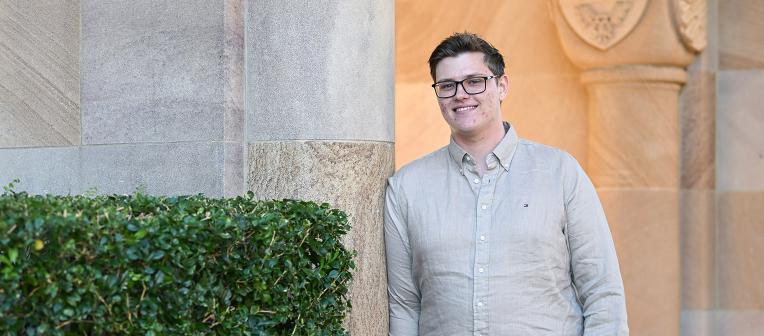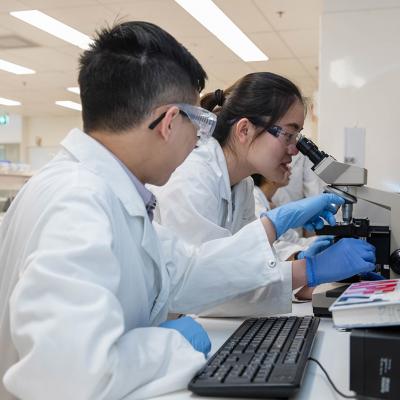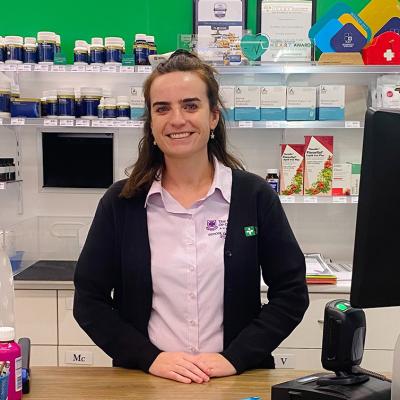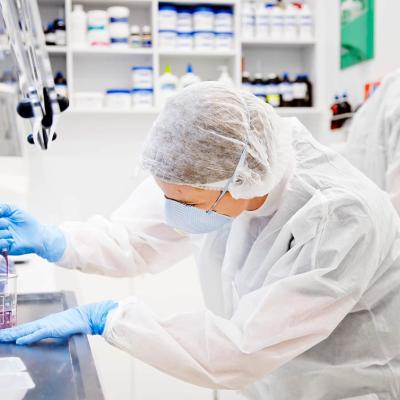Heart-shaped tablets for lowering cholesterol. Multi-coloured ‘polypills’ for mixed medications. And chocolate-flavoured gummies for treating anxiety and depression.
The possibilities are virtually endless with Liam Krueger’s research into 3D-printing technology. His work has the potential to transform the pharmaceutical industry – and it all began with his undergraduate degree at UQ.
Since completing a part-time, year-long research project in the 4th year of his Bachelor of Pharmacy (Honours), Liam has been exploring the potential impact 3D printing could have for pharmacists and patients. He was so fascinated with the topic that he’s now pursuing it further with a PhD.
Perfecting his pharmaceutical 3D printing
Almost every kind of 3D printing relies on a polymer as the main component. So, picking the best polymer for the job is the natural starting point.
Since his research focuses on medication for oral consumption (tablets), Liam needs to work with polymers that:
- are biocompatible (not harmful to ingest)
- will dissolve in the gastrointestinal tract.
For example, acrylonitrile butadiene styrene (ABS) is a polymer that’s very easy to 3D print and used to make LEGO. Unfortunately, it’s also toxic to cells and doesn’t dissolve in water or hydrochloric acid, the main fluids in our stomachs. This means ABS isn’t suitable for 3D printing medical tablets (and you definitely shouldn’t eat LEGO, no matter how tempting it is).
The good news is that plenty of polymers do meet these criteria, giving Liam a variety of materials to work with. Once a polymer candidate is chosen, it’s time to test it with different drugs and other substances.
“After that, it’s basically combining the active ingredient with the polymer* and using additives to hone the properties,” says Liam.
“For example, if its melting point is too high or the polymer is too brittle, we can add excipients* like plasticisers.”
“Then, after we print the tablets, we use pharmacopoeia* to assess their quality against conventional tablets in terms of their dose accuracy, how fast they dissolve, and even how strong they are.”
*Some handy translations:
- Polymer: A natural or synthetic substance made of large molecules chained together (examples include polystyrene, silicone, wool, silk, cellulose, and even DNA).
- Excipient: A non-active substance within a tablet (such as preservatives, colouring agents, and plasticisers). Many drugs would be too small to store and consume properly if they weren't combined with excipients.
- Pharmacopoeia: A set of medical standards outlining the acceptable qualities of therapeutic drugs.
Choosing a new polymer has been one of the biggest recent changes in Liam’s research. Doing so has enabled him to 3D print tablets at lower temperatures, allowing him to work with a wider variety of medications.
“Most drugs are much more thermally stable than you might think; however, some will degrade under excessive heat over prolonged periods of time,” says Liam.
“I previously needed to print at around 190°C, but I’m optimising a new formulation with a new polymer to get as low as 100°C, which will be compatible with almost every active ingredient.”

What impact will the 3D printing of medical tablets have?
For Liam, the most exciting aspect of the technology is being able to 3D print customisable ‘polypills’. These are tablets containing multiple medications, tailored to the patient’s prescriptions.
“It’s becoming very common to see people regularly taking 10+ medications per day, and it’s too easy to forget to take your medicine or take the right dose at the right time,” he says.
“Our biggest aim is to make medications easier to take by combining them into a single tablet and, in turn, decrease hospitalisations and deaths due to poor adherence.”
Non-adherence is a significant issue that places extra strain on the healthcare system, with studies finding only half of prescriptions are followed correctly. Liam hopes that removing the complexity of taking multiple medications could help improve this statistic.
But 3D-printed tablets won’t just be easier to remember – they could also be more enjoyable to take. The process is flexible enough that you can alter almost any aspect of the tablets, including their size, shape, colour, texture, and flavour.
This customisability creates a range of possibilities, like:
- Tablets can be printed smaller to help patients with problems swallowing.
- Tablets can be given a squishy texture like gummies.
- Tablets can have bright colours, fun shapes or even tasty flavours to make them more appealing.
While he’s still optimising the 3D-printing process and narrowing down the best combinations of ingredients, Liam is now turning his attention to how he'll turn his research into reality.
“I’ve also been focusing on the clinical side of things and having discussions with industry partners, regulatory bodies, compounding pharmacies and clinicians to explore how we could actually translate this technology into practice,” he says.

How else is 3D printing used in healthcare?
Liam isn’t the only researcher looking into the applications of this technology for medical professionals. 3D printing in the healthcare industry is also being used to:
- create artificial living tissue via ‘bioprinting’ for medical research (this may eventually offer an alternative to organ transplants)
- create replicas of patients’ organs to help surgeons prepare for operations
- print precise and affordable surgical instruments
- custom-make prosthetic limbs and implants (e.g. UQ Associate Professor Dr Sean Peel has worked with cranio-maxillofacial surgeons to create 3D-printed implants and models of human anatomy).
Liam’s experience at UQ
Liam thoroughly enjoyed chemistry in high school, which led him to consider the Bachelor of Pharmacy (Honours) at UQ. He was surprised at first by how different studying pharmacy is to studying chemistry, but he quickly discovered it was a perfect field for him.
“While there definitely is some chemistry and biology in pharmacy, drug knowledge is sort of a field of its own,” says Liam.
“It is a happy accident that I actually really enjoyed learning about drugs and what I’m most motivated about now – the concept of personalised medicine.”
Throughout his undergraduate program, Liam found learning about cardiovascular drugs particularly interesting. He was fascinated by how impactful tiny substances could be in helping with all kinds of health conditions.
“It seems absurd that, with the right cocktail of medications, we can effectively treat and prevent things like strokes and heart attacks,” he says.
“We routinely use medications to dissolve clots, thin the blood, decrease blood pressure, slow the heart, and reduce cholesterol, ultimately resulting in significantly better chances of survival and life expectancy.”

Liam also found that studying on UQ’s dedicated pharmacy campus, Dutton Park, made for a unique and convenient experience.
“I love that everything pharmacy-related is in one building,” he says.
“The labs, the library and even the café are all in one place, which makes day-to-day study very convenient. Plus, the massive St Lucia campus is not too far out of the way – just a short trip over the river.”
Of course, the UQ community comprises much more than the buildings and facilities. Liam's teachers and peers also contributed to the fantastic time he had during his bachelor’s degree, as well as encouraging him to stay at UQ to complete a Doctor of Philosophy. This is especially true of Associate Professor Amirali Popat.
“Amir is my principal PhD supervisor, and he was also my supervisor for the 4th year majors project that originally got me into this field of research,” says Liam.
“His support is one of the biggest reasons I even considered doing a PhD in the first place.”
“Everybody within my lab has been super friendly and supportive, which has made for a great experience throughout my studies and research.”
Where will studying pharmacy take you?
If you’re thinking of studying pharmacy at university, Liam is living proof that this field of study can be immensely interesting and rewarding. When he’s not advancing his 3D-printing research, he works as a community pharmacist – a role he thoroughly enjoys.
“Pharmacists have amazing potential to save lives and make sure that we’re using medications in the right way,” he says.
“No other health professional will have the drug knowledge and expertise that you do.”
“Pharmacists are trusted by patients, have great job security with a decent salary, and have an internationally recognised qualification – you can practise in other places like the UK and Canada with relatively little extra training.”
Want to discover how you could create change in the healthcare industry just like Liam?






